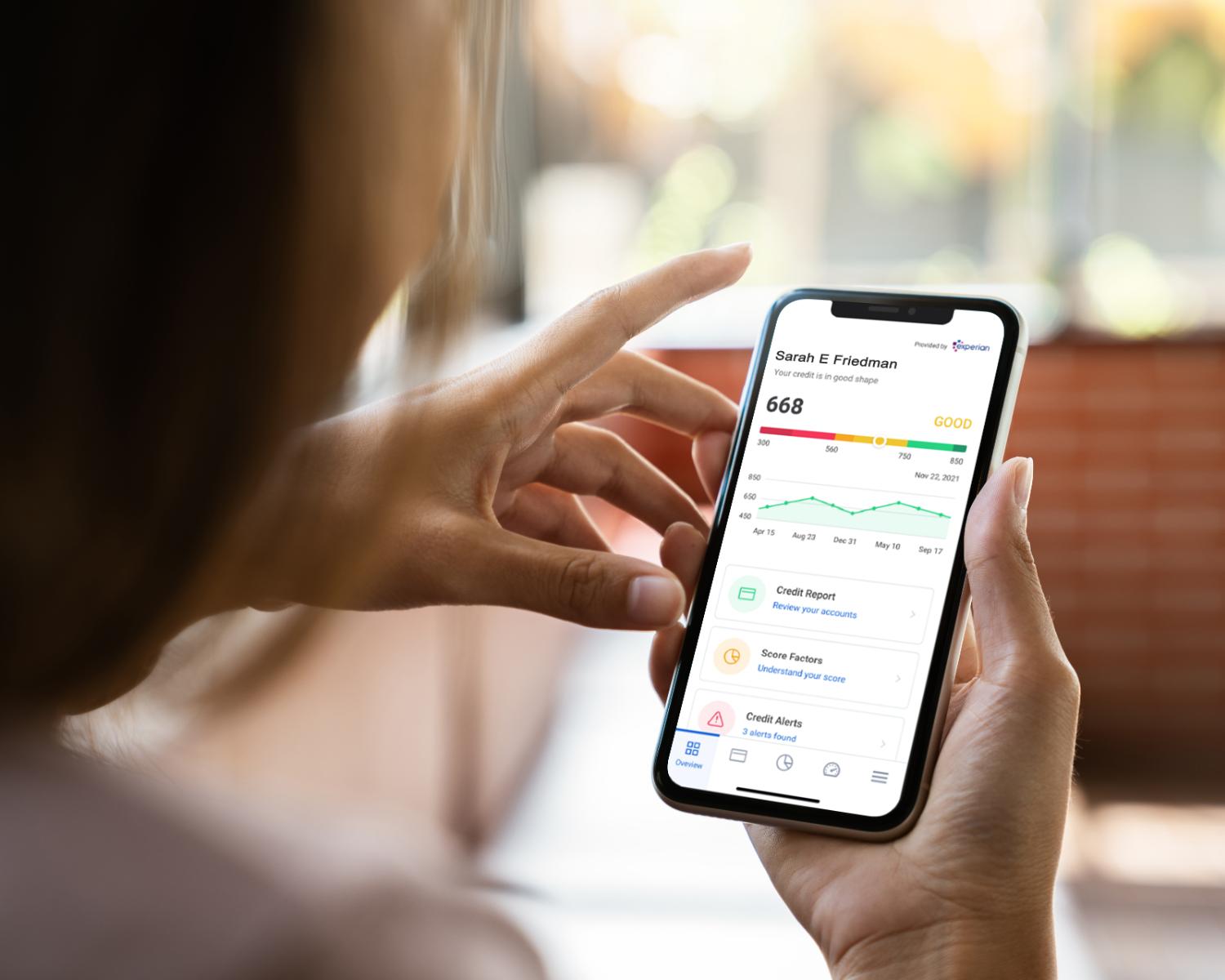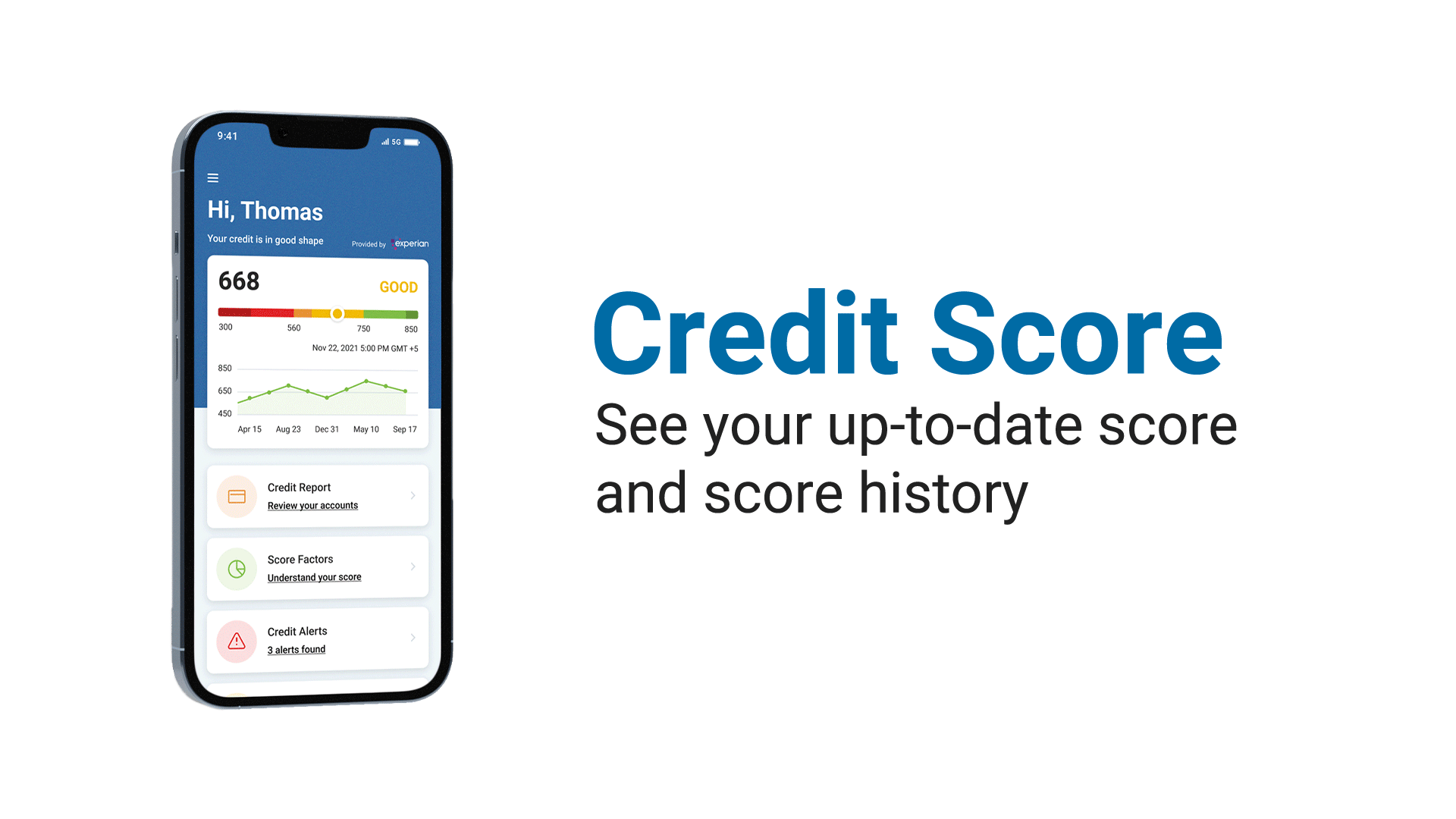
Credit score report & tools
Now you can access your credit score and report when you log into Online Banking! MyCredit is a credit score and report monitoring tool which is FREE to all Online Banking Members.

 Manage
ManageStay on top of your credit with alerts if your score changes and monitor information like your name, email and SSN.
See how your credit score might change when you take certain actions like getting a loan or opening a new credit card.
Track and manage your debt in one spot; easily see open balances and monthly payments and more.
Your credit score, wherever you go.

MyCredit FAQ's
What is MyCredit used for?
MyCredit provides Members the ability to monitor and access their credit score and report all from within Online Banking.
MyCredit provides Members the ability to monitor and access their credit score and report all from within Online Banking.
Who can benefit from MyCredit?
Anyone! Whether you are looking to buy a home, purchase a new vehicle, or simply want to know where your score is at, MyCredit can help.
Anyone! Whether you are looking to buy a home, purchase a new vehicle, or simply want to know where your score is at, MyCredit can help.
Will my credit be affected by checking my score on MyCredit?
No. MyCredit conducts what is called a "soft pull" on your credit score information. It pulls score data from three major bureaus: Equifax, Experian, and TransUnion.
No. MyCredit conducts what is called a "soft pull" on your credit score information. It pulls score data from three major bureaus: Equifax, Experian, and TransUnion.
How do I improve my credit score?
You can take several steps to improve your credit score, but be aware that there are no quick fixes. You may be able to see your score tick up soon after you start trying to improve it. However, credit reports are updated month by month and it may take several months or even years before your credit score is where you want it to be.
You can take several steps to improve your credit score, but be aware that there are no quick fixes. You may be able to see your score tick up soon after you start trying to improve it. However, credit reports are updated month by month and it may take several months or even years before your credit score is where you want it to be.
- Pay your bills on time
- Reduce your credit utilization
- Avoid or limit opening new accounts
- Keep older accounts open
- Consolidate debt
- Use credit monitoring
Why is my score different from other banking apps?
The credit bureaus pull your information from many different sources (such as lenders, collections, court records) at different times, there will always be discrepancies at any particular time between the reports from each credit bureau. Each of the three credit bureaus (Equifax, Experian, and TransUnion) uses a different model to calculate a credit score and each gathers data independently.
The credit bureaus pull your information from many different sources (such as lenders, collections, court records) at different times, there will always be discrepancies at any particular time between the reports from each credit bureau. Each of the three credit bureaus (Equifax, Experian, and TransUnion) uses a different model to calculate a credit score and each gathers data independently.
How do I dispute and correct inaccurate information in my credit report?
If you discover information on your credit report that you believe is inaccurate, you can take the following steps to dispute the information.
If you discover information on your credit report that you believe is inaccurate, you can take the following steps to dispute the information.
- Highlight the errors on your credit report
- Gather supporting documents that show your side of the story; for example, receipts or bank records showing that you made a payment on time that’s recorded as late or delinquent.
- Submit the information to the credit bureaus with a brief explanation (100 words or less).
You may find that some companies have forms on their websites that you can use, such as one offered by CFPB. CFPB dispute information.
How is my credit score calculated?
The three major credit bureaus, Equifax, Experian, and TransUnion, provide detailed information about a consumer’s credit activity to companies that calculate a credit score. The two major companies providing credit scores are FICO ® and VantageScore ®. Each uses a proprietary method to calculate their score.
The three major credit bureaus, Equifax, Experian, and TransUnion, provide detailed information about a consumer’s credit activity to companies that calculate a credit score. The two major companies providing credit scores are FICO ® and VantageScore ®. Each uses a proprietary method to calculate their score.
FICO considers the following factors when calculating your score:
Payment history (35%)
Do you make your payments on time?
Do you make your payments on time?
Amounts owed (30%)
Do you owe too much to too many lenders?
Do you owe too much to too many lenders?
Length of credit history (15%)
Does your record show that you can maintain your commitment over a period of time?
Does your record show that you can maintain your commitment over a period of time?
New credit (10%)
Have you opened multiple new accounts in a short period of time?
Have you opened multiple new accounts in a short period of time?
Credit mix (10%)
Do you have a variety of account types, such as credit cards, installment loans, or a mortgage? VantageScore 3.0 considers the following factors when calculating your score
Do you have a variety of account types, such as credit cards, installment loans, or a mortgage? VantageScore 3.0 considers the following factors when calculating your score
Payment history (40%)
Repayment behavior, such as whether you pay on time or have delinquencies.
Repayment behavior, such as whether you pay on time or have delinquencies.
Depth of credit (21%)
How long you’ve been using credit.
How long you’ve been using credit.
Utilization (20%)
The ratio between available credit and used credit.
The ratio between available credit and used credit.
Balances (11%)
Total amount of reported debt.
Total amount of reported debt.
Recent credit (5%)
The number or recent accounts opened plus credit inquiries (hard inquiries).
The number or recent accounts opened plus credit inquiries (hard inquiries).
Available credit (3%)
Amount of credit available.
Amount of credit available.
Both FICO Score and VantageScore range from 300 to 850. However, they divide the categories
differently.
differently.
FICO ® Score categories
300 – 499: Very poor
500 – 600: Poor
601 – 660: Fair
661 – 780: Good
781 – 850: Excellent
300 – 499: Very poor
500 – 600: Poor
601 – 660: Fair
661 – 780: Good
781 – 850: Excellent
VantageScore 3.0 ® categories
300 – 600: Subprime
601 – 660: Near prime
651 – 780: Prime
781 – 850: Superprime
300 – 600: Subprime
601 – 660: Near prime
651 – 780: Prime
781 – 850: Superprime
FICO produces several models of their FICO Score to accommodate different types of lending. Models also vary depending on which bureaus provide the data for them. The most common model is FICO Score 8, which along with FICO Score 9 are widely used for lending. Both use data from all bureaus, as do most other models.
FICO Score models that are more specific include FICO Auto Score and FICO Bankcard Score,
for lending associated with car purchases and credit card applications. Scores for these models
range from 250 – 900.
for lending associated with car purchases and credit card applications. Scores for these models
range from 250 – 900.
Mortgage lending uses FICO Score 2, FICO Score 5, and FICO Score 4, which use data from
only one of the three bureaus.
only one of the three bureaus.
Disclaimer: FICO® Scores are developed independently by Fair Isaac Corporation. Most, but not all, lenders use FICO® Scores to determine a consumer's creditworthiness. We're not affiliated with FICO and have no influence on producing a FICO Score.
